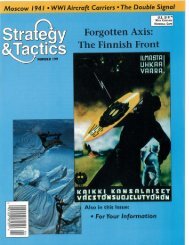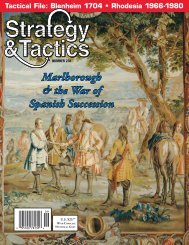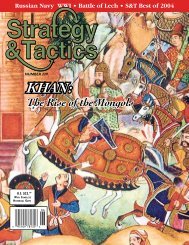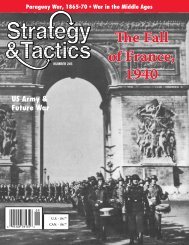the franco-prussian war - Strategy & Tactics
the franco-prussian war - Strategy & Tactics
the franco-prussian war - Strategy & Tactics
You also want an ePaper? Increase the reach of your titles
YUMPU automatically turns print PDFs into web optimized ePapers that Google loves.
TORPEDOES:Mark/Model Dia - - wt - -- Wrnd - -Performance Utilization-< -MklO steam 21" 2100' 415 3500136 -Subs ----'Mk13 steam 22" 1921 600 3000136 AIC, PTMk14 ste, 2: 500 4500146 Subs9000132Mkl5steam 21" 2215 660 4400148 Surface shlps880013215000126.5I403. TorpedoesA relatively good discussion of <strong>the</strong> difficultieswe faced with our torpedoes, <strong>the</strong> only problemis that both <strong>the</strong> Mk 10 and Mk 14 types listedwere submarine torpedoes. The standarddestroyer torpedo was <strong>the</strong> Mk 15 which was aBliss-Leavitt model using <strong>the</strong> same MI C pistolof <strong>the</strong> Mk 14, making it equally as unreliable as<strong>the</strong> Mk 14. Also, <strong>the</strong> standard rack mountedtorpedo for <strong>the</strong> Higgins type PT boats was <strong>the</strong>22" Mk 13 aircraft torpedo, although <strong>the</strong> Elcoboats carried <strong>the</strong> Mk 15 in tubes. The Mk 15was a fairly good weapon once <strong>the</strong> bugs of1942 were ironed out. At any rate it wasreplaced in 1944 by <strong>the</strong> Mk 18, an electrictorpedo copied from <strong>the</strong> German G7e-FATelectric. The accompanying table may help toplace <strong>the</strong>m in perspective.While looking at torpedoes, <strong>the</strong> main Japanesesurface ship torpedo was <strong>the</strong> Type 93, butmany of <strong>the</strong> older DDs and CLs as well as allsubmarines carried <strong>the</strong> Type 81, a 21" steamjob (YUNAGI and TENRYU did at Savo).Japanese aircraft and MTBs carried a 1760 Ib.18" type with a 440 Ib. <strong>war</strong>head which mayexplain why it took five to sinkCHICAGO although fewer would have probablybeen sufficient had <strong>the</strong>y been in rapidsuccession ra<strong>the</strong>r than two followed by threemore some 20 hours later. This carries over to<strong>the</strong> Hit and Hit Hard area and may explainsome of <strong>the</strong> differences in <strong>war</strong>ship resistanceto torpedo as well as o<strong>the</strong>r damage.4. Hit and Hit HardWhat ship is <strong>the</strong> BENTON? Please pass thisinformation on as apparently you havediscovered a destroyer even <strong>the</strong> USN did notknow existed.Morrison credits WASHINGTON with onlynine 16" hits out of 75 rounds fired atKIRISHIMA. They were all that were necessaryto save SOUTH DAKOTA'S bacon for, in spiteof <strong>the</strong> fact that her engineering spaces werestill intact, she had lost one 16" turret and wasa blazing pyre that was attracting 14" shellslike moths. It would not have been too muchlonger before her luck would have run out andshe, too, would have suffered a critical injury.5. Who Won.Again, in <strong>the</strong> discussion of Cape Esperance itshould be noted that <strong>the</strong> Japanese achieved<strong>the</strong>ir objective, Sumiyoshi landed with hisartillery and tanks safely.C. "CA" GAME RULESA fair number of errors are in section 12.0, ShipCharacteristics.1. So DakotaIN Carolina 38,000 tons2. Iowa 48,500 tons- 7DD/sS - -- ""--"'"3. Maryland only 3 units (4th, WASHINGTON,sunk 1924)4. Baltimore 13.600 tons5. Omaha 5 units CL-1, 5 type CL-26. Atlanta 4 units 16x5" 8x21"TT4 units 12x5" 8x21"TT3 units 12x5" 0 TT7. Sims DD 12 units 4x5" 8x21"TT (extramounts removed 1941)8. Craven 22 units9. Benson DD-5 should be Bristol Class10. Benson 2 1620 tons1. Agano 6~5.9"2. Akatsuki should be DD-23. Asashio should be DD-44. Hatsuharu should be DD-3a (6x24"TT)5. CHOKAI should be CA-2a (4x4.7"AA.8x24"TT)6. MAYA should be CA-2b (8x5"AA, 8x24"TT)7. Tenryu 6x21"TT8. Mutsuki 2x4.7"DP, 6x24"TT9. Kamikaze DD-la 3~4.7". 4x21"TT (YAYOI)This seems to be about all I wish to cover atthis time. Please do not interpret what hasbeen written here as anything o<strong>the</strong>r than someconstructive criticism. I noticed that <strong>the</strong>re wasno listing of source materials, but it appears asif you rested heavily on Jack Coggins' TheCampaign for Guadalcanal which is a fair workbut tends to perpetuate many of <strong>the</strong> mythsthat more thorough researchers have disproven.It would be to you advantage to havesomeone with a reasonable knowledge of <strong>the</strong>subject check <strong>the</strong> accuracy of future endeavorsin this area. At <strong>the</strong> risk of soundingpresumptious, may I suggest that someone likemyself be utilized in <strong>the</strong> area of naval and navalair fields. I have a relatively extensive technicaland descriptive library on <strong>the</strong> subject and havewritten an article on Guadalcanal in Conflict,plus collaborated with Dave Dickson on his IanAllen series book on <strong>the</strong> Philippine Sea battle. Iwould like to offer my services on <strong>the</strong> abovescore if you feel that <strong>the</strong>y may help to providea more accurate publication.The following is a response to Mr. Hafting'scomments by David lsby, author of "CA."A. MAIN ARTICLEKEYED TO HARTING'S COMMENTS1. Pg. 12. Agreed that <strong>the</strong> Japanese did notrun over <strong>the</strong> Pacific firing off expensiveordnance, but <strong>the</strong>ir torpedo training techniqueswere still more realistic than <strong>the</strong>Americans, as I'm sure you would agree2. While <strong>the</strong> U.S. also disposed of someobsolete <strong>war</strong>ships by sinking <strong>the</strong>m, <strong>the</strong>se weremainly by air (OSTERFRIEDLAND, VIRGINIA,and o<strong>the</strong>rs) or by o<strong>the</strong>r means, includinggunfire (WASHINGTON). My comment was,however, in relation to torpedo use. It shouldbe noted that <strong>the</strong> Americans stopped thispractice once <strong>the</strong> immediate surplus of shipsresulting from <strong>the</strong> Naval Treaties had beenexhausted.3. All ships tend to be designed "underweight"and gradually flesh out, through building andreconstruction, to a much larger displacement.That <strong>the</strong> AOBA's were designed to stay within<strong>the</strong> Treaty limits is obvious, and quite possibly<strong>the</strong> o<strong>the</strong>rs too, but I feel you could not get <strong>the</strong>kind of armament and protection of ships suchas <strong>the</strong> ATAGO on 10,000 tons. Your commentsabout <strong>the</strong> U.S. Treaty crusiers is interesting.4. As should have been clear from <strong>the</strong> article,<strong>the</strong> Japanese had <strong>the</strong>ir battleship Admirals,who remained unconvinced, in some cases,until YAMATO went down. However, <strong>the</strong>rewere enough of <strong>the</strong> "Carrier Admirals" in <strong>the</strong>right position at <strong>the</strong> right time to have shapedJapanese opening strategy. The Japanesewere definitely disappointed in not havingpicked up <strong>the</strong> carriers at Pearl, but I feel <strong>the</strong>ideas expressed in <strong>the</strong> article find amplegrounds in <strong>the</strong> Japanese use and deploymentof <strong>the</strong>ir battlewagons (squadrons of battleshipsbeing Senkan Sentai) in <strong>the</strong> first sixmonths of <strong>the</strong> Pacific War. Also, from <strong>the</strong>writings and interviews with Japanese Navalofficers in <strong>the</strong> U.S. Naval Institute's TheImperial Japanese Navy in World War /I and in<strong>the</strong> Strategic Bombing Survey's Naval volumes,especially those with Admirals Toyodoand Fukudome and Capt. Fuchida.5. The fighting at Java Sea lasted some threehours, <strong>the</strong> rest of <strong>the</strong> time being used for <strong>the</strong>ABDAFLOT and Japanese to sort <strong>the</strong>mselvesout. These "wild" torpedo shots wereprobably deliberate and kept <strong>the</strong> ABDAFLOTforces from moving in closer, where <strong>the</strong>ir 6"and 5.9" guns would be more effective.6. "Marianas" should read "Marshalls" -refering to <strong>the</strong> "Big E's" strike on Kwajelein.The abortive relief of Wake Island - whichwas unsuccessful partially because of <strong>the</strong>miscalculations of Jack Fletcher, could also beconsidered in this category.7. If <strong>the</strong> American carriers could haveemotions, I'm sure that <strong>the</strong>y would have beenfearful too. The "mistake" was Fletcher's, but Icould hardly term it "lunacy." Fletcher wasquite capable of making big mistakes, but I fearat Savo only hindsight makes him wrong.What would you have done if you were JackFletcher on that night? If I were in his shoes,I'm afraid I might very well have done<strong>the</strong> same thing.8. Your account of Cape Esperance differs inone point from Morrison's official history, fromwhich may account is largely drawn. I believeHELENA informed Scott of its sighting byusing TBS (Talk-Between-Ships Radio Telephone)soon after.2325, while you have thisaction taking place some five minutes later.When one deals with such fine tolerances insomething such as a night naval battle,something is sure to get lost in <strong>the</strong> translation.The logs of <strong>the</strong> ships involved would often notmesh by as least as much time. Scott hadintended to countermarch when he did,







